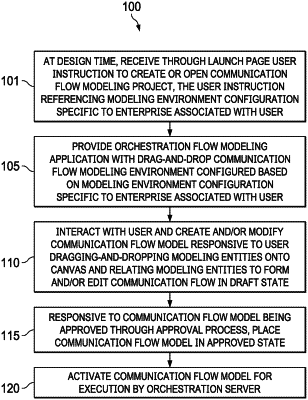| CPC H04L 41/18 (2013.01) [G06F 16/958 (2019.01); H04L 41/0253 (2013.01); H04L 67/02 (2013.01)] | 20 Claims |

|
1. A method, comprising:
receiving, by a computer, an instruction from a user device to open or create a communication flow modeling project in an application, the instruction referencing a configuration for a communication flow modeling environment at design time of the communication flow modeling project;
opening or creating, by the computer, the communication flow modeling project in the application, wherein the configuration defines entity-specific modeling entities for inclusion in the communication flow modeling environment within the application such that the application provides a canvas and a menu of the entity-specific modeling entities in the communication flow modeling environment;
responsive to a set of entity-specific modeling entities being dragged from the menu and dropped onto the canvas, performing, by the computer:
drawing connections between the set of entity-specific modeling entities;
logically connecting the set of entity-specific modeling entities to form a communication flow for controlling how a communication flows from a data source through a document architecture to a communication channel; and
storing the communication flow in a database in a draft state;
responsive to the communication flow being approved, placing, by the computer, the communication flow in an approved state; and
activating, by the computer, the communication flow for execution at runtime by an orchestration server, wherein, at runtime, the orchestration server loads the activated communication flow from the database, runs the communication flow on the document architecture, and orchestrates services provided by the document architecture in accordance with the communication flow without requiring user input.
|